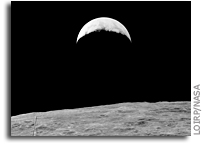Looking at Earth From the Moon (Again) in 1966
 The ‘Other’ Lunar Orbiter 1 Earthrise Image, Lunar Orbiter Image Recovery Project
The ‘Other’ Lunar Orbiter 1 Earthrise Image, Lunar Orbiter Image Recovery Project
“A newly enhanced image of Earth taken from lunar orbit 47 years ago has been released. The image, taken by Lunar Orbiter 1 in 1966, is the latest in a series of images released by the Lunar Orbiter Image Recovery Project (LOIRP). This image is actually one of a pair of images taken of Earth by Lunar Orbiter 1. Its twin image, taken first, was much more famous and captured the world’s imagination when first released by NASA nearly half a century ago. That “Earthrise” image, as it came to be known, was also the first image re-released by the LOIRP in November 2008. These two pictures were not included in the original mission plan. Taking these images required that the spacecraft’s attitude in relation to the lunar surface be changed so that the camera’s lenses were pointing away from the Moon. Such maneuvering meant a calculated risk and, coming early in the flight, the unplanned photograph of Earth raised some doubts among Boeing management about the safety of the spacecraft – especially on the very first Lunar Orbiter mission.”









The rugged terrain at low altitude always reminds me of title of the Heinlein book, “The Moon is a harsh Mistress”, though the harshness in the story is mostly man made.
Is the Lunar Orbiter 1 first photo of the whole Earth really the first photo of the whole Earth? Did the Soviets beat us that that “first” as well? Otherwise, maybe this represents turning of the tide in the space race. A compendium of all the first (earliest) photos of the Earth would make a nice book or web page at least.
Last but not least, CONGRATULATIONS to this team that has now completed extraction of all the mag tape data and transferred to digital. It would have been a great loss to allow the mag tape and data to rot. But that raises the question – what magnetic tape data from early missions have been lost?
Reading a little on Lunar Orbiter, they actually had an automated photo lab on board and other tech to solve problems that was very challenging for the time, partly due to the state of solid state electronics of that time.
The gradation scales at the bottom of each photo are from the original prints created in the spacecraft in the automated lab, right? Blemishes are from defects in processing in the automated lab, too. Very cool.
If any of these photo rolls or emulsions survived impact – I suspect some parts did, they would have turned to dust in the dry climate conditions of the harsh mistress. If the canisters survived that hold the photo material, they might be recoverable. The impact of these vehicles on the Moon might be somewhat like the impact of a professional race car that sheds K.E. through absorption and disintegration of the body structure.
Rocky
The Calibration strips, including the grey scale charts, resolution bars and linearity patterns were all pre exposed on the film before launch. Thus the images could be scaled and calibrated after retrieval on the Earth.
As for survivability? It would be interesting would it not!
Orbital velocity for the Moon is about 1.6 km/s… anything hitting the Moon at that speed is going to be quite obliterated, you might be able to find small fragments, but most of it would have actually vaporized on impact.
Yes, about 500x the K.E. of a race car. Its beyond the everyday that most humans see and can comprehend. A tank penetrating projectile matches speed, high velocity bullets half the speed. A satellite, a compound object, acts much more like a monolithic object in a vacuum at high velocity. But its fun to imagine the possibilities. An object that is more extended in size could benefit from vaporization gases of impact to force a more graceful deceleration of some components.
Yes, this was the first picture of the Earth from the vicinity of the Moon (though the first picture of the “whole Earth” was taken by Lunar Orbiter 5), and yes, the “turning of the tide” in the space race was about this time as well, but not because of the Lunar Orbiter program. Project Gemini was in full swing, and it was during Project Gemini that the USA surpassed the USSR both in man-hours in space and in technical achievements. Notably, Gemini 7, which spent nearly 14 days in space, and Gemini 12, which performed EVAs that demonstrated that the severe spacesuit overheating problems and many previous difficulties in performing spacewalks were overcome. Overall the Gemini program demonstrated that spacecraft were capable of rendezvous and docking in orbit and capable of reentering the Earth’s atmosphere and landing near a predetermined location.
Beautiful … Great work, you guys!
Another great image but somewhat bittersweet when the level of activities on and around the moon 50 years ago are compared to what is going on today.
But I don’t mean to take away from the fantastic and terrific work you guys are doing. So important to preserve our space faring heritage.